Time to sum up part two of our 30 Days Wild! If you missed part one, you can find it here: Exploring Nature With #30DaysWild, Part One: Day 1-10. To find out what we did during day 11-20, keep reading below!

DAY 11: BEAUTIFUL BINDWEED & A MERMAIDS PURSE
On this day, went down to the sand dunes at Camber. It was a cloudy weekday evening and wonderfully crowd free.
We found that many of the dunes were covered in flowering Sea bindweed, which we haven’t seen much of there before, despite visiting those dunes pretty regularly over the past 3-4 years. Perhaps they have benefited from the place being relatively empty this spring, due to the lockdown? Or maybe they would have a good year anyway, who knows? Either way, it was beautiful!

We also found a ’mermaids purse’ (on the beach below the dunes). We come across them quite often, but made a point this time of picking it up to have a closer look, and commenting on what it is. It’s not actually a mermaid’s purse (surprise!), but an egg case. The one we found is most likely from a Spotted Ray, but other rays and skates have similar egg cases, and small sharks like catsharks and dogfish have egg cases of a similar type too (though more elongated and with long curly strings). I found a good guide about egg cases on sharktrust.org, so if you find some and would like to figure out what species they come from, that’s a good place to start.

I still find these egg cases quite exotic, as I never saw any growing up, outside Stockholm. As far as I know, there are no species in the Baltic Sea which lay egg cases of this kind, or similar. Do you find them where you live…?
DAY 12: HOVERFLIES
I was very happy to find out that 22-29 June is National Insect Week here in the UK. It fits in really well with our ongoing studies of pollinators, as well as with the 30 Days Wild.
We’ve certainly seen lots of different insects on our walks around the countryside this month. For example, we saw these hoverflies all over the oxeye daisies at Rye harbour nature reserve, during our walk there on day 12 of 30 Days Wild.
I’ll admit straight away that my knowledge of hoverflies is extremely limited, and I’ve never taken much interest in them before. I even thought that a hoverfly is just a hoverfly… they’re all the same, right? Eh nope, apparently there are over 270 species of hoverfly just in Britain!
Penguin isn’t really interested in the names of different species of hoverfly (no surprise there, ha!), but if you are, there’s a guide to the main larger ones you may spot in the UK on bna-naturalists.org
Do you have a favourite type of insect? I think mine might be dragonflies, although there are some very cool beetles and moths too… Though choice!
PS. Does anyone else get the terms ’naturalist’ and ’naturist’ mixed up…?
DAY 13: MORE FLOWER POWER…
If you hop back to day 10 (in part one of our #30DaysWild) you’ll find that I said I’d post more about other activities we’ve done for learning about plants & pollination. At least one of these were done on day 13, so they get to represent the day in this sum-up. And to make it easy, I’ll just present you with my instagram post on this, as that also means I can easily include a short video clip. So, please read below and swipe through to see more photos & video:
DAY 14: GRAVEYARD WILDERNESS
On this day, we got our daily dose of ‘wilderness’ visiting a graveyard.

The graveyards I have memories of from my growing up in Sweden, were generally very neat, with gravelled paths and neatly trimmed box hedges forming a framework of straight lines around the rows of well-kept gravestones. (On a side note, I always used to like the smell of graveyards, and I later realised that it was in fact the smell of those neatly cut box hedges.)
This graveyard we visited, like many other English graveyards, had a good amount of areas where nature is allowed to dominate and do it’s thing. I like that. It feels like a reminder of the circle of life, I think, which seems quite appropriate.
Anyhow, on this particular graveyard visit, we sat down under a large magnolia, and found it had a large amount of lichen growing on its branches.
One of the very few things I know about lichen is that the bushy, ’beard-like’ and leafy types are indicators of good air quality, as they’re quite sensitive to pollution.
There was also a plaque on the tree, telling us it was a Magnolia Kobus, and that it was in memory of two ladies with Swedish names, which felt like a funny coincidence.
After sitting under the magnolia for a while, just taking in the surroundings, listening to the birdsong etc, we took a walk around the other parts of the graveyard. Not all of it was allowed to grow wild as you can see, but there was certainly a good amount of wildflowers, grasses etc to be enjoyed by wildlife of the smaller varieties, such as bees and other insects.
We also stopped to look at the little baby acorns starting to form on one of the oaks there. Once they fall to the ground and start to decay, they will again be the source of new life…

DAY 15: SEA, SAND & CORMORANTS
On day 15 we found ourselves a relatively unbusy beach. The sea was super far out due to the very low tide, and we didn’t even attempt to reach it. Instead we sat down and enjoyed the sand (Penguin in particular, pouring, digging and writing letters in it), and we kept our eyes peeled for any wildlife…
There were of course plenty of seagulls (mostly Herring gulls), and we also watched a little beetle struggling across the sand. But the most exciting thing we saw on this afternoon was a group of cormorants. They flew in from the sea and went right above our heads, so we got a great view of them!
I know they’re not the most popular bird, due to the amount of fish they eat and the amount of excrement they subsequently create, and like to cake their favourite spots in… But they’re quite impressive with their characteristic shape and wingspan, which measures about 130-160 cm in adults. And it was cool to see a group of them in flight like this! We’ve mostly seen them sitting around before, and I like how their silhouettes look almost like a group of planes crossing the sky (or is it actually the planes that look like cormorants? Hmm…?).
By the time we were finished on the beach, Penguin had a significant part of it stuck in his hair, and ended up with a small sandpit in the bottom of the bath that night. A sign of beach-time well spent, I think!
DAY 16: BEE HAPPY…
On day 16 we went for a fairly short evening walk around a field on the outskirts of a small village in the countryside, not too far from where we live. It was one of those days when I REALLY felt the need to get out and focus on little things to be found in nature (rather than the troubles of the world, which do little good for my sanity).

We found a path that led diagonally through a farmers field where some kind of grass-like crop was growing, possibly ‘foraging rye’ which is grown as animal fodder. Once we got to the other side of it, we decided to follow the perimeter of the field back to our starting point. There were plenty of wildflowers, grasses, thistles and weeds growing along the borders between this field and the next, and I’m assuming that the farmers keep it that way as it supports the survival of bees and other pollinators and ‘mini-beasts’. At least I’m hoping that’s a conscious choice they’ve made, and one I’m sure is contributing to the amount of birdsong that we heard as well.
I like the rusty red weed pictured on the right, above. It’s called curly dock or curled dock, or just dock or dockweed, or even yellow dock, apparently. What do you call it? When I was a child, in Sweden, we used to call it ‘coffee plant’ (‘kaffeväxt’), as the reddish flowers eventually turn dark brown and dry, making them perfect to use as a kind of ‘coffee granules’ in the play kitchen. Something nice to serve with the mud cakes and other tasty treats!

The most exciting thing we found on this walk was a tree that had been struck by lightning and was scorched black on the inside. I’m sure there are beetles who appreciate that tree being left like that as well.
This was just a short walk, but still felt like we saw a lot on it. I guess it’s mostly about taking notice… And I definitely felt a lot happier after our walk. I think all three of us needed it!
DAY 17: WILD ABOUT THE TIDE?
For this one, I’m giving you another instagram post (click play to watch the video):
DAY 18: MORE BEACH-BASED LEARNING
On this late afternoon, we went back down to the same beach as previous evening. But the change in weather made it feel like a different place! The day before it was very cloudy, calm, quiet and almost empty of people, while this time it was sunny and bright with a strong breeze, and more busy with kite-surfers, dog walkers etc. Still plenty of room for distancing though, thankfully!
The people who Penguin is watching here are doing some shrimping. They’ve got large push nets, and walk with them in the shallow water, catching shrimps and/or other smallish sea creatures, which I suspect they’ll use for bait, for fishing. Though you could just eat the shrimps yourself, too.
We also did some beach themed ’table-time’ learning at home, earlier in the day. We watched a YouTube video of Prof Brian Cox explaining why we have tides, and looked back at videos and pics we took on the beach the evening before.
We then went on to identify some of the seashells we’ve collected over the years, mainly with the help of this page on countryfile.com (plus also this image of seashells and their names). How many of these shells can you name without looking them up?

DAY 19: HIDDEN VIEWS
On day 19, we stopped at a church we’d not been to before. We were hoping there might be a footpath leading out into the countryside at the backside of the graveyard, but we didn’t really know what to expect, as you can’t see from the roadside what might be hidden on the other side, behind bushes, trees and the church building itself.
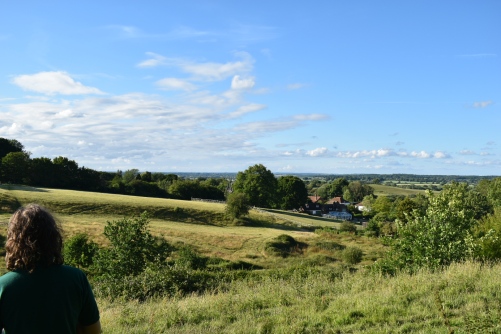
We were very pleasantly surprised! There was indeed a footpath (well, two actually), leading out onto rolling hills with miles-wide views. There were sheep grazing, and some areas with long grass and wildflowers. We spotted a few butterflies, but none that would land long enough for us to get a proper look at them.
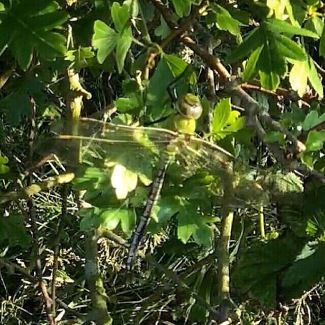
The most impressive creature we spotted on this walk though, was a huge dragonfly! The biggest I’ve ever seen for sure. We looked it up after we got home, and it seems it was a female Emperor dragonfly.
I did manage to catch this ‘empress’ on film, but I think it’s safe to say that I’m no David Attenborough… The video can be seen in the instagram post below (something for you to laugh at, if nothing else)!
DAY 20: SUMMER NIGHTS
Have you noticed how when the light fades, our visual sense isn’t as useful as in broad daylight, so our other senses step up to the plate and become more important to us?
On the longest day of the year, which was also day 20 of our 30 Days Wild, we went for a very late evening walk. Most of the sheep and lambs in the fields had already cuddled up for the night. The bats on the other hand were very much awake! Sadly I didn’t catch them on film this time though…
The water in the river was calm and mirror-like, and the air was filled with smells of summer: warm soil, flowers, salt from the sea, and erm… ‘fertiliser’ from the sheep.
One of the houses near us has a big honeysuckle with heavily scented flowers sprawling up over their fence, and we stopped to enjoy that. The scent was amazing, and the flowers look fantastic at night too, coloured by the streetlight.
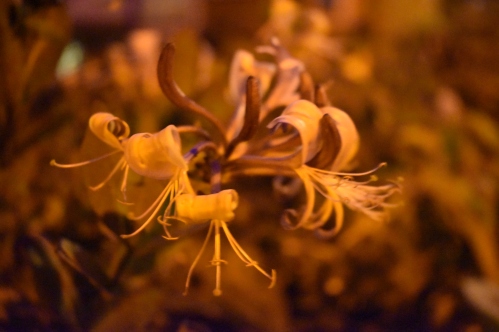
Summer nights are a great source of sensory delights, aren’t they?
*******
THAT WAS DAY 11-20 OF OUR 30 DAYS WILD! I hope this post, as well as part one in the series, has provided you with some inspiration and ideas for outdoorsy learning. I’m hoping to get the third and final post of this series done in a few days time. See you soon!
PS. See picture below for the names of the seashells we identified! The ones called ’Common’ anything, such as the Common Limpet for example, we’ve left out the ’Common’ for (hence just ’Limpet’, etc.). I hope you learnt something from this, we certainly did! x

PIN THIS POST!

Linking up with:







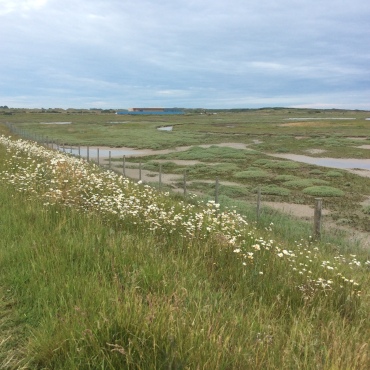














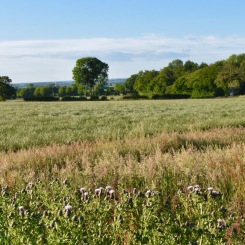















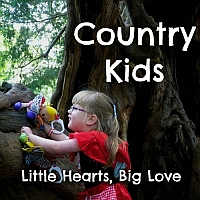
What a fantastic post! And you’ve really put me to shame with your outdoor nature activities in June, I’m really impressed. How old is Penguin? I’m finding it a real struggle getting Caroline outdoors these days and I’m wondering if it’s an age thing?
LikeLiked by 1 person
Thank you! Penguin is 13 now, but as he’s not a ‘typical’ 13 year old, it’s tricky to make any comparisons. Though I do hear from a lot of other parents of teens that they too struggle to get their kids outside much.
This year of course has been extra strange, and I’ve heard quite a few people saying their children have become anxious about going anywhere. The ‘stay home’ message might have been almost TOO efficient sort of, for some.
I hope it’s just a phase for you, and that Caroline is happy with life in general. Sometimes our kids don’t want to do what we had wished for them, but as long as they are reasonably happy, that’s what really matters, I think? ❤ xx
LikeLike
I love all your little Swedish anecdotes too #CountryKids
LikeLiked by 1 person
Aww thanks (again!) 🙂 x
LikeLike
Amazing post with amazing photos.
I would have loved to explore that graveyard.
#KCACOLS
LikeLiked by 1 person
Thank you so much, Melinda! I’m happy to hear that you too love a good graveyard 🙂 xx
LikeLike
I keep meaning to have a go at 30 days wild with my kids, it looks like you had lots of fun!
#KCACOLS
LikeLiked by 1 person
Thank you, yes it’s been great fun! I hope you get around to joining in with it next year. Although of course you can take time to enjoy outdoorsy activities at any time of the year! x
LikeLike
Love learning outside. The world is a classroom. As a homeschooling family I’ve missed learning taking place outside in the world during lockdown. I’m looking forward to getting out more.
#kcacols
LikeLiked by 1 person
Oh yes, you are so right about the world being a classroom. And we too have missed some of the places we would usually have visited, like animal parks, historical buildings, aquariums etc. The #30DaysWild definitely help us focus on what we still COULD do, rather than what wasn’t available to us due to lockdown x
LikeLike
How wonderful that you’ve been able to get outside in nature everyday! And to the beach, even better. #kcacols
LikeLiked by 1 person
It’s been really great, and I’m so thankful the weather has been on our side too! x
LikeLike
Lots of lovely outdoor activities for #30DaysWild. I’ve heard of mermaid’s purses although have never seen one before and I never knew that they were egg cases. How fascinating to be able to take a closer look at one. We have lots of hoverflies in the garden – again I’ve learned something new as I didn’t realise there were so many species of those either. I love dragonflies and damselflies too. Graveyards can be such peaceful places to stop and look at nature and it is lovely to see the areas where nature is just left to its own devices. That scorched tree looks fascinating. Those shells are pretty. I couldn’t name any of them though! I had an Emperor dragonfly in my garden last week. They are beautiful. Love your late evening walk too – the photos are beautiful. Thank you for sharing your wild adventures with #CountryKids
LikeLiked by 1 person
Thank you so much for your lovely comment, Louise! I’m glad you learnt something from me/us this time, I often learn things from your posts! How cool that you had an Emperor dragonfly in your garden recently, they are amazing creatures (and a bit scary when flying right at your face, lol) xx
LikeLike
We really enjoyed doing 30DaysWild too. You packed so much fun and learning into each of your days! #KCACOLS
LikeLike
It looks like a huge amount of fun. It’s great getting outside and exploring, everything there at your disposal and it hardly costs a penny! It sounds like a great activity to do with kids #KCACOLS
LikeLiked by 1 person
Thank you Tracey! Yes exactly, nature is there and pretty much for free, with plenty to explore. It’s a win-win really 😀 x
LikeLiked by 1 person
So nice to see so many blue skies – what fun you’ve had! #KCACOLS
LikeLiked by 1 person
Thank you! I think we’ve been pretty lucky with the weather this year so far (except perhaps in February), and that’s certainly made our outdoor explorations all the more pleasant x
LikeLiked by 1 person
Nice blog!
LikeLiked by 2 people
Thank you! 🙂
LikeLiked by 1 person